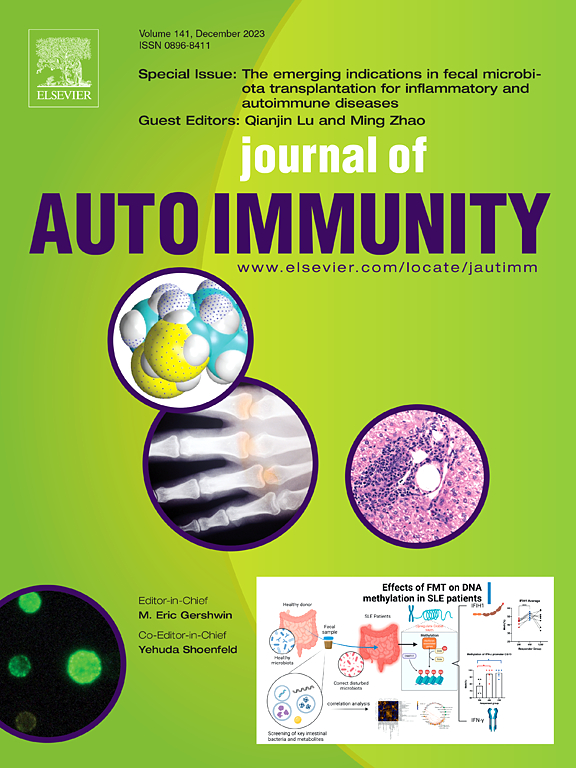Treatment of mixed connective tissue disease: A multicenter retrospective study
IF 7
1区 医学
Q1 IMMUNOLOGY
引用次数: 0
Abstract
Introduction
Mixed connective tissue disease (MCTD) is a rare systemic disorder that belongs to connective tissue diseases (CTD). Few studies are available on MCTD treatment.
Methods
We conducted an observational study within the French MCTD cohort. Data were collected at diagnosis, during follow-up, and at the last follow-up (LFU). We studied three treatment groups i) no treatment, ii) hydroxychloroquine (HCQ) and/or glucocorticoids (GC) and iii) disease-modifying antirheumatic drugs (DMARDs)/immunosuppressant (IS).
Results
Three hundred and fifteen patients were included and followed for 96 [40–156] months. At MCTD diagnosis, 52 (16.5 %) patients were treatment-free, while 224 (71.1 %) received GC and/or HCQ and 39 (12.4 %) received DMARDs and/or IS. During follow-up, 10 (3.2 %) patients remained treatment-free, and 77 (24.4 %) were GC-free. Most patients (n = 271; 85.8 %) received HCQ, and 161 (51.1 %) were treated with DMARDs and/or IS. DMARDs and/or IS, including anti-B cell therapeutics, were more frequently prescribed in patients with musculoskeletal involvement (p < 0.0001), interstitial lung disease (ILD, p < 0.0001) and/or pulmonary arterial hypertension (PAH, p < 0.01). Patients in clinical remission and those who did not evolve to a differentiated CTD (MCTD-dCTD) received significantly less frequently DMARDs and/or IS (including anti-B cell therapeutics; p < 0.0001 for both). Patients who received HCQ at MCTD diagnosis appeared to develop less frequently ILD or PAH (p < 0.05).
Conclusion
HCQ and GC were the cornerstones of MCTD treatment and were sufficient to control disease manifestations in nearly half of the patients, reflecting the good prognosis of this disease. DMARDs and IS were used for musculoskeletal involvement, PAH/ILD, and in MCTD-dCTD patients.
混合性结缔组织病的治疗:一项多中心回顾性研究
混合性结缔组织病(MCTD)是一种属于结缔组织病(CTD)的罕见全身性疾病。很少有关于MCTD治疗的研究。方法我们在法国MCTD队列中进行了一项观察性研究。在诊断时、随访期间和最后一次随访(LFU)时收集数据。我们研究了三个治疗组:i)不治疗,ii)羟氯喹(HCQ)和/或糖皮质激素(GC)和iii)改善疾病的抗风湿药物(DMARDs)/免疫抑制剂(IS)。结果共纳入315例患者,随访96个月[40-156]。在MCTD诊断时,52例(16.5%)患者未接受治疗,224例(71.1%)接受GC和/或HCQ治疗,39例(12.4%)接受DMARDs和/或IS治疗。随访期间,10例(3.2%)患者无治疗,77例(24.4%)患者无gc。大多数患者(n = 271;85.8%的患者接受了HCQ治疗,161例(51.1%)接受了DMARDs和/或IS治疗。DMARDs和/或IS,包括抗b细胞治疗,更常用于肌肉骨骼受累的患者(p <;0.0001),间质性肺疾病(ILD, p <;0.0001)和/或肺动脉高压(PAH, p <;0.01)。临床缓解的患者和未发展为分化型CTD (MCTD-dCTD)的患者接受dmard和/或IS(包括抗b细胞治疗;p & lt;两者均为0.0001)。在MCTD诊断时接受HCQ的患者似乎较少发生ILD或PAH (p <;0.05)。结论hcq和GC是MCTD治疗的基础,足以控制近一半患者的疾病表现,反映了该病预后良好。DMARDs和IS用于肌肉骨骼受累、PAH/ILD和MCTD-dCTD患者。
本文章由计算机程序翻译,如有差异,请以英文原文为准。
求助全文
约1分钟内获得全文
求助全文
来源期刊

Journal of autoimmunity
医学-免疫学
CiteScore
27.90
自引率
1.60%
发文量
117
审稿时长
17 days
期刊介绍:
The Journal of Autoimmunity serves as the primary publication for research on various facets of autoimmunity. These include topics such as the mechanism of self-recognition, regulation of autoimmune responses, experimental autoimmune diseases, diagnostic tests for autoantibodies, as well as the epidemiology, pathophysiology, and treatment of autoimmune diseases. While the journal covers a wide range of subjects, it emphasizes papers exploring the genetic, molecular biology, and cellular aspects of the field.
The Journal of Translational Autoimmunity, on the other hand, is a subsidiary journal of the Journal of Autoimmunity. It focuses specifically on translating scientific discoveries in autoimmunity into clinical applications and practical solutions. By highlighting research that bridges the gap between basic science and clinical practice, the Journal of Translational Autoimmunity aims to advance the understanding and treatment of autoimmune diseases.
 求助内容:
求助内容: 应助结果提醒方式:
应助结果提醒方式:


